3.5. Use as aquafeed
Because of its attractive nutritional qualities and the relative ease of production, a significant number of studies have been carried on the potential utilization of duckweed biomass as fish feed (Shireman, Colle and Rottmann 1977, 1978; Hillman and Culley, 1978; Stephensen et al., 1980; Gaigher, Porath and Granoth, 1984; Naskar et al., 1986; Hassan and Edwards, 1992). Available literature indicates that duckweeds are fed to fish in fresh form as a sole feed or in combination with other feed ingredients (Figure 3.5).
Duckweeds are also fed as a dried meal ingredient in pelleted diets. Intensive fish production with duckweed as a predominant feed constituent has been reported by a number of authors (Hepher and Pruginin, 1979; Robinette, Brunson and Day, 1980; Culley et al., 1981; Landolt and Kandeler, 1987, Skillicorn, Spira and Journey, 1993). Research studies on the use of duckweed as fish feed have been carried out under laboratory as well as under field conditions. Successful results have also been obtained on the on-farm utilization of duckweed as fish.
3.5.1 Laboratory studies
Figure 3.5
Duckweed collected from the pond to be fed to tilapia, Kumah Farms Complex (Kumasi, Ghana)
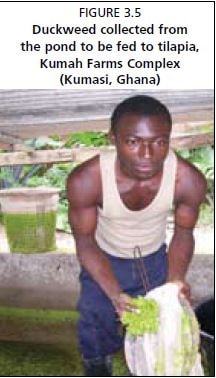
Successful feeding trials for grass carp with duckweed have been carried out since the early 1960s. Studies on the consumption of duckweed by aquatic animals have generally been confined to this species, although more recently feeding trials have also been carried out with others, including common carp, catfish, Indian major carps and tilapia.
Results on the use of duckweed as a feed for grass carp are generally very positive (Galkina, Abdullaev and Zacharova, 1965; Nikolskij and Verigin, 1966; Fischer, 1968, 1970; Edwards, 1974; Porath and Koton, 1977; Shireman, Colle and Rottmann, 1977, 1978; Baur and Buck, 1980; Hajra and Tripathi, 1985). Galkina Abdullaev and Zacharova (1965) reported that the grass carp showed more rapid growth when using duckweed than other feed materials. Porath and Koton (1977) noted that the weight of grass carp could be tripled (from 100 g to 300 g) within 50 days when feeding a mixture of L. gibba and L. minor.
Fresh duckweeds have also been efficiently utilized by common carp, catfish, Indian major carps and tilapia (Hepher and Pruginin, 1979; Robinette, Brunson and Day, 1980; Stephensen et al., 1980; Gaigher, Porath and Granoth, 1984; Naskar et al., 1986; Hassan and Edwards, 1992).
Summary results of selected growth studies carried out on the use of fresh and dried duckweed as feed for different fish species are presented in Tables 3.13 and 3.14. Fresh and dried duckweed were fed to grass carp, Nile tilapia, common carp, Indian major carps (rohu and mrigal), silver carp, Java barb, hybrid grass carp and hybrid tilapia. The duckweed species evaluated were L. gibba, L. perpusilla, L. minima, L. minor, Wolffia columbiana and W. arrhiza. Fresh duckweeds were fed as a sole feed whereas dried duckweed meal was incorporated by partially replacing other conventional feed ingredients in pelleted diets. Feeding trials were conducted for varying periods, ranging from 60 to 155 days. Fish were fed ad libitum or at restricted level. In some studies,
Table 3.13
Performance of fish fed fresh duckweed
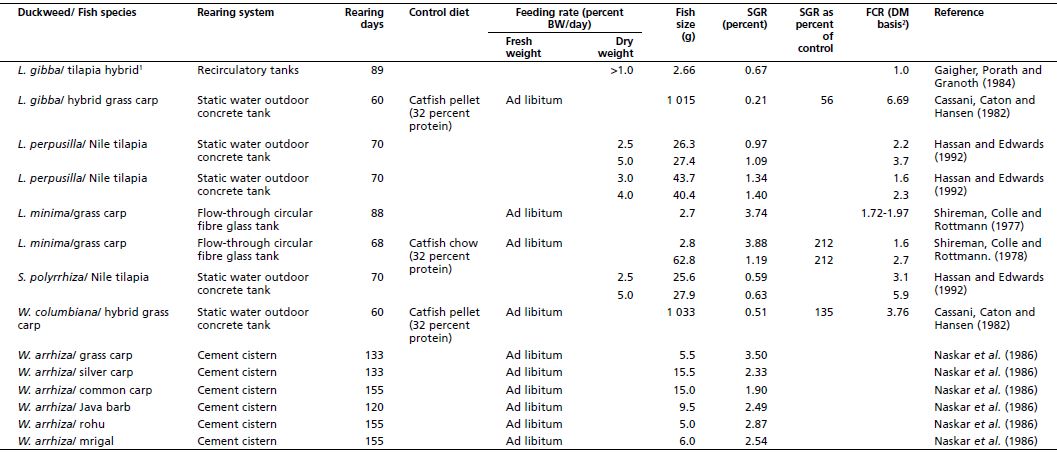
1 O. niloticus X O. aureus
2 Dry matter basis
Table 3.14
Performance of fish fed pelleted feeds containing dried duckweed

the performances of fish fed duckweed were compared with control diets, although in many of these studies no control diet was used for comparison.
Growth responses of different fish species fed various species of fresh duckweed were variable. However, the general trend was that the grass carp performed better than Nile tilapia and other species and the performances of duckweed as whole feed were better than control diet (Table 3.13). Similarly, duckweed meal incorporated in pelleted diets at 13.5 and 40 percent showed similar growth responses compared to the growth responses of fish fed control diets (Table 3.14). The SGRs obtained for grass carp fed fresh duckweed as whole feed varied between 1.2 and 3.9 while the SGR values for Nile tilapia were between 0.6 and 1.4. Fasakin, Balogum and Fasuru (1999) reported that duckweed meal (Spirodela polyrrhiza) can form up to 30 percent of the total diet of Nile tilapia without significant effect on performance, compared to a control without duckweed. However, inclusion levels above this level progressively decreased fish performance.
Duckweed are generally the preferred macrophytes for most of the herbivorous fish, although several authors reported that submerged macrophytes such as oxygen weed (Hydrilla) and water velvet (Najas) are more preferred than others. The preference of duckweed to other aquatic plants has been reported for grass carp and other fish species in several observations (Opuszynsky, 1972; Duthu and Kilgen, 1975; Rifai, 1979; Cassani, 1981; Cassani and Caton, 1983). Information on whether fish prefer any particular duckweed species over others is lacking.
Ad libitum feeding of fresh duckweed is mostly used for herbivorous fish. Limited numbers of investigations have been carried out to optimize the feeding or consumption rate of duckweed but most were carried out for grass carp and Nile tilapia. Nikolskij and Verigin (1966) reported grass carp consumed fresh duckweed equal to their body weight over a 24 hour period. Baur and Buck (1980) reported that grass carp consumed from 85 percent to 238 percent of their body weight/day (BW/day) on a mixed diet of Lemna, Spirodela and Wolffia spp. Shireman, Colle and Rottmann (1977) recorded consumption rates varying from 7.2-7.4 percent BW/day on a dry weight basis (DW) for grass carp while fresh duckweed (L. minima) was fed ad libitum. Since duckweed contains about 92 percent moisture, the dry weight feeding rates given above are equivalent to about 90-92 percent BW/day on a fresh weight basis. Shireman, Colle and Rottmann (1978) fed fresh L. minima ad libitum to grass carp and recorded daily mean consumption rates of 7.6 percent and 4.3 percent BW/day DW for 2.8 and 62.8 g sized fish respectively. Similar size-dependent feeding rates were reported by Hassan and Edwards (1992) for Nile tilapia. These authors studied the effect of feeding rate of L. perpusilla on the survival, growth and food conversion rate of Nile tilapia and recorded that the optimal daily feeding rates of Lemna were 5, 4 and 3 percent BW/day DW for fish of 25 to 44 g, 45 to 74 g and 75 to 100 g, respectively. Hassan and Edwards (1992) concluded that duckweed should be fed to tilapia according to its consumption rate, in order to avoid creating adverse water conditions, and that the feeding rate should be decreased as the fish grow larger.
A study by Effiong, Sanni and Sogbesan (2009) also indicated that the inclusion of duckweed meal in fish feeds could improve its binding potential and water stability.
3.5.2 Field studies and on-farm utilization
Several field studies and reports about the on-farm utilization of duckweed as feed for various fish species exist (e.g. Edwards, 1980, 1987; Edwards, Pacharaprakiti and Yomjinda, 1990; Skillicorn, Spira and Journey 1993; DWRP, 1998).
Edwards (1987) reported the on-farm utilization of duckweed in China and Taiwan Province of China. This author reported that the duckweeds L. minor, S. polyrrhiza and W. arrhiza are cultivated in small shallow ponds (similar to that illustrated in Figure 3.6) fertilized with manure (livestock or human) and fed to grass carp fry and fingerlings in nursery areas. Initially the fry are fed the smaller Wolffia, but when they reach 6 to 7 cm in length they are fed the larger Lemna and Spirodela. In Taiwan Province of China a mixture of Lemna and Wolffia is cultivated in shallow earthen ponds fed with faecally-polluted surface water for use as fish feed.
Skillicorn, Spira and Journey (1993)described the ‘duckweed-fed carp polyculture system’ developed in the PRISM experimental farm at Mirzapur, Bangladesh. The duckweed (Lemna, Spirodela and Wolffia) carp polyculture model has an 18-month cycle. Fingerlings were introduced in August and
Figure 3.6
Two boys collecting duckweed from a village pond (Jessore, Bangladesh)
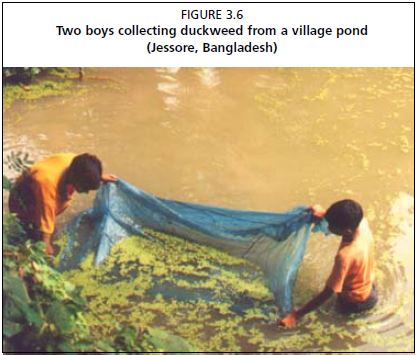
September and harvesting began in March and continued for approximately one year. A second 18-month cycle began the following year and continued concurrently for six months. After the initial six months, the model allowed year-round harvesting. Bi weekly harvesting was the preferred pattern, following a simple protocol to take the largest fish (75 to 100 percentile) and the smallest (0 to 25 percentile) in each species. The rationale was the assumption that the largest fish will exhibit a declining growth rate and that the small fish are simply poor performers.
The production rates achieved in this programme suggested that one hectare of duckweed production can support two hectares of carp polyculture. Empirical results suggested that a polyculture stocked at about 30 000 fish/ha may be fed as much duckweed as they will eat daily, regardless of the season. Fish were fed duckweed throughout the day. Freshly harvested duckweed was brought in baskets to the pond and distributed evenly among several ‘feeding rings or squares’ (Figure 3.7) consisting of 4 m2 open-bottom enclosures. Feeding rings provide access by the fish to the duckweed and prevent it from dispersing over the pond surface. The feeding ring can be a floating enclosure anchored near the shore. Six feeding rings/ha were installed in the Mirzapur experimental site and appeared to provide sufficient access to food for all fish. Figures 3.8 and 3.9 show the transport and utilization of duckweed in fish culture.
In the Mirzapur experimental ponds, grass carp was the primary consumer of duckweed in the polyculture. However, both catla and common carp also competed aggressively for available duckweed feed and consumed it directly.
Figure 3.7
Duckweed cultivated in an undrainable pond (Mymensingh, Bangladesh)
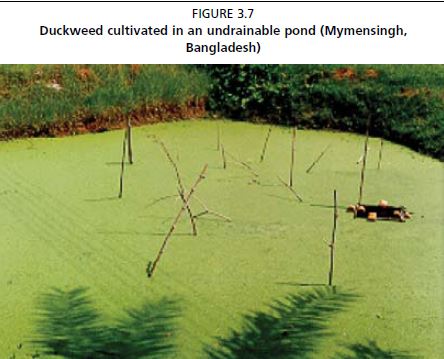
Figure 3.8
A duckweed collector carrying a bag of duckweed in a rickshaw van. These professional duckweed collectors collect duckweed from various derelict ponds and sell them to fish farmers (Jessore, Bangladesh)
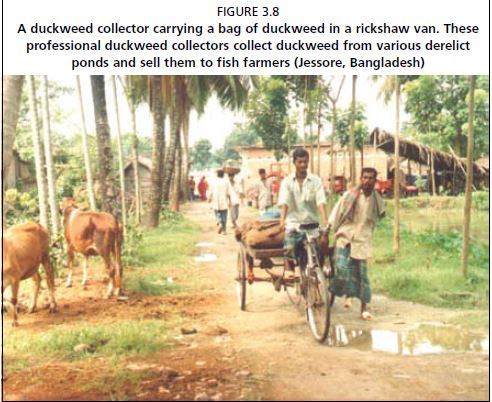
Top-feeders directly absorb about 50 percent of duckweed nutrients in their digestive systems. Their faeces contain the balance of the original duckweed nutrients and furnish relatively high quantity detritus to the bottom-feeders. A duckweed-fed fish pond thus appears to provide a complete, balanced diet for those carp that consume it directly, while the faeces of duckweed feeding species, which are consumed directly by detritus feeders or indirectly through fertilization of plankton and other natural food organisms, provide adequate food for the remaining bottom and mid-feeding carp varieties. The fertilization of a duckweed-fed fish culture is therefore indirect and gradual, resulting from bacterial decomposition of fish faeces, dead algae, and other fermenting organic material.
Skillicorn, Spira and Journey (1993) reported that
Figure 3.9
A farmer is releasing a bag of duckweed to his carp pond. These duckweeds are generally purchased from a group of professional duckweed collectors (Jessore, Bangladesh)
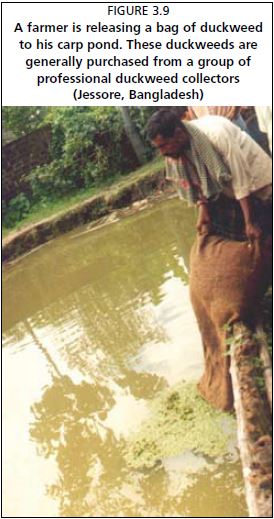
the first annual cycle of carp production produced slightly more than 10 tonnes/ha/year. However, these authors opined that a yield of between 10 to 15 tonnes/ ha/year appears to be sustainable before biological constraints become limiting factors.
DWRP (1998) reported further follow-up of the duckweed-fed carp polyculture system developed by PRISM in Bangladesh. This report included the results of the demonstration farms as well as the results of the farmers’ ponds. The duckweed-fed carp polyculture system practised by PRISM had two distinct differences from the model described by Skillicorn, Spira and Journey (1993). Apparently, PRISM included Nile tilapia with the traditional six-species carp culture system and provided other supplemental feed along with the duckweed. The farmers that adopted duckweed based aquaculture produced an average of 3.6 tonnes/
ha/year in comparison to the national average fish production of 2.1 tonnes/ha/year in Bangladesh at that time. PRISM itself achieved a production level of 11 tonnes/ha/year in 1993 and 16 tonnes/ha/year in 1996 in its demonstration farm.
The results of the duckweed-based carp polyculture of PRISM are presented in Tables 3.16, 3.17 and 3.18. Table 3.15 presents fish stocking and harvesting data in 1994. Tilapia were not stocked but multiplied on their own. Data for feed application, fish yield and food conversion ratio in farmers’ ponds and in demonstration farms of PRISM are presented in Tables 3.16 and 3.17. The specific influence of duckweed feeding on yield and food conversion was obscured because other supplemental food was also added to the fish ponds. In neither demonstration ponds nor farmers’ ponds could any example be found of pure duckweed feeding.
Table 3.17 presents data collected from demonstration farm production in Mirzapur over a period of three years. The results from fish ponds fed duckweed from organic wastewater plants have been kept separate from those fed on duckweed grown on chemical fertilizers. Whether there has been any difference in nutritive value between the duckweed from these different treatments could not be checked. What is interesting is to compare the difference in the ratio of duckweed to the other supplemental feed that was being applied. At first the information in Table 3.17 suggests that higher proportions of duckweed influence the conversion rate adversely. This conclusion may not be true, however, since the total amount of food applied in the ponds treated with waste-grown duckweed was clearly too high. Since the ponds did not show any increased production with a high rate of feeding, it must be assumed that they were at their carrying capacity most of the time and that all the extra food offered was apparently wasted. This seems to imply that the sustainable level of fish production from a duckweed-based polyculture lies around 10-15 tonnes/ha/year.
Table 3.15
The ratio of fish species stocked and harvested by PRISM in 1994
Table 3.16
Feed application, fish yield and food conversion ratio in farmers’ ponds in two locations in Bangladesh during 1995-96
Table 3.17
Feed application, fish yield and food conversion ratio in demonstration ponds at Mirzapur Experimental Site, Bangladesh during 1993-95
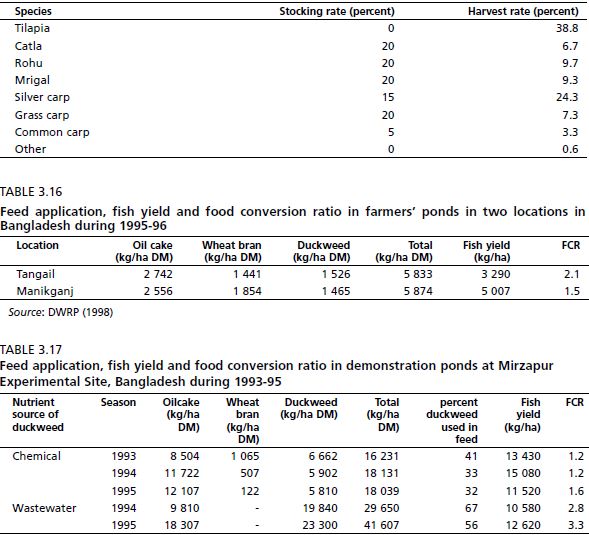
Source: DWRP (1998)
The food conversion values obtained when various duckweed species were fed to different fish species are presented in Table 3.18. Duckweeds were fed mostly in the fresh form and most of the values available are for grass carp and Nile tilapia. The values are variable, but the available data does not indicate if the variability was due to the fish species or to the duckweed species used. Generally, most FCRs are between 2.0 and 3.0, although an FCR of 1.0 was reported for hybrid tilapia and a very high FCR (6.7) for hybrid grass carp when both were fed L. gibba. This latter result was probably due to size of the fish (>1.0 kg) used in the feeding trial. Shireman, Colle and Rottmann (1978) reported an FCR of 1.6 for 2.8 g grass carp when fed fresh L. minima but the FCR was 2.7 for 63 g fish. Hassan and Edwards (1992) reported that food conversion was significantly affected by the feeding rate. For example, the FCR was 3.1 when S. polyrrhiza was fed to Nile tilapia at a feeding rate of 2.5 percent BW/day whereas it was 5.9 at a feeding rate of 5.0 percent BW/day. Similarly, FCR increased from 2.2 to 3.7 with an increase in feeding rate from 2.5 to 5.0 percent BW/day for Nile tilapia when fed L. perpusilla.
Generally, the FCR values reported for duckweed-based polyculture of carps in Bangladesh (Tables 3.16 and 3.17) were very good, being between 1.5 and 2.1 for farmer’s ponds and 1.2 to 1.6 for demonstration ponds. However, it must be pointed out that duckweed was not used as the sole feed in these ponds, which were usually fertilized in addition to the use of oilcake, rice bran and wheat bran as supplemental feeds. Low FCRs for duckweed may be expected, since these plants have relatively low fibre and high protein contents (Table 3.12) and a good amino acid profile (Annex 1 Table 3). Although it is difficult to generalize from the available data, an FCR value of 2.5 may be a reasonable expectation for grass carp and Nile tilapia based.
Table 3.18
Food conversion ratios of duckweed to fish
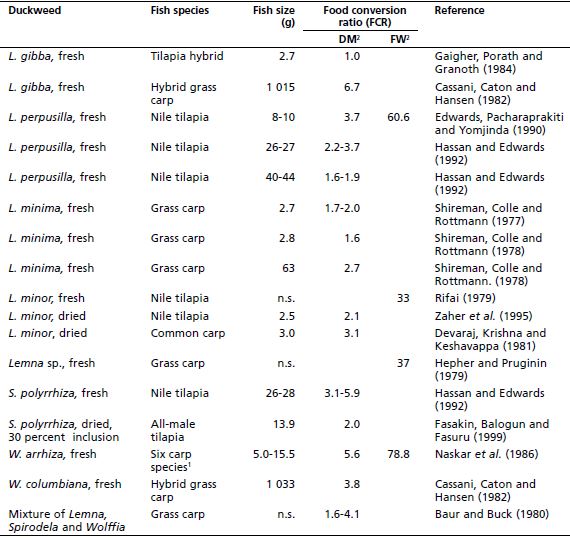
1 Polyculture of six carp species (grass carp, silver carp, common carp, Java barb, rohu and mrigal) 2 FW = fresh weight basis; DM = dry matter basis
Floating aquatic macrophytes – Duckweeds 51
Digestibility coefficients of Lemna, Spirodela and Wolffia fed to grass carp, tilapia and rohu are presented in Table 3.19. Considering the importance of duckweed as fish feed, it is surprising to note that only a few studies have been carried out to investigate its digestibility for fish. Van Dyke and Sutton (1977) were probably the first to investigate the digestibility of duckweed (mixture of L. minor and L. gibba) in detail for grass carp. These authors estimated the true dry matter digestibility of duckweed to be 65 percent, while the apparent digestibility was 53 percent for dry matter, 80 percent for crude protein, 58 percent for organic matter, 26 percent for ash and 61 percent for gross energy. The dry matter digestibility of L. gibba, S. polyrrhiza and W. arrhiza for grass carp found by other authors (Table 3.19) varied between 67-82 percent, while the dry matter digestibility of L. gibba for hybrid tilapia was reported to be 65 percent. Grass carp passes its food rapidly through a short, unspecialized gut and the fish probably does not produce cellulase (Van Dyke and Sutton, 1977); it is therefore unrealistic to expect that more than 50-60 percent of the feed consumed would actually be digested.
Table 3.19
Digestibility of duckweed for selected fish species
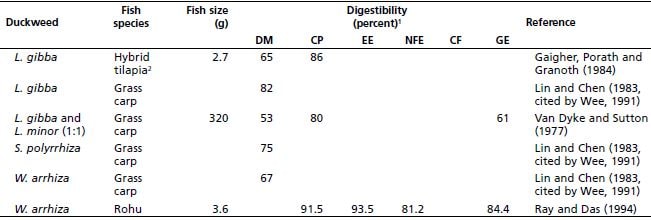
1 DM = dry matter; CP = crude protein; EE = ether extract; CF = crude fibre; NFE = nitrogen free extract; GE = gross energy 2 O. niloticus X O. aureus